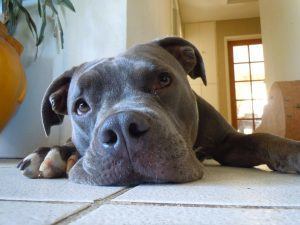
5 Holiday Items That Can Hurt Your Pet
5 Holiday Items That Can Hurt Your Pet
The Holidays are a wonderful time to enjoy good company and great food. But some holiday food items and items are actually toxic to pets, and can cause serious health issues – such as the painful and life-threatening illnesses pancreatitis and bloat. In this article, you will gain a handy list that explains which common holiday foods and items are harmful for your pet. This way, with some easy planning and a bit of caution, you can just relax and enjoy the holidays!

#1 – Fatty Foods and Table Scraps
Any fatty meats are very harmful to dogs – such as pork products, meat drippings, turkey skin, and table scraps. This can cause a host of stomach issues, such as vomiting, diarrhea, and internal injury. More troublingly, fatty foods can cause pancreatitis in dogs.
Pancreatitis is a serious and potentially life-threatening illness. Older and overweight dogs are especially at risk. The pancreas is an organ in your dog’s body that is responsible for helping to digest food through the release of enzymes. Normally, these enzymes are activated only once they reach the small intestine. When a dog experiences Pancreatitis, the enzymes are activated before they normally would be, and can damage the dog’s pancreas and surrounding internal organs and tissues. This is very painful, and can cause devastating effects. This is why it is so important to never feed your dogs fatty foods. Symptoms of pancreatitis include:
- Vomiting
- Hunched Back
- Bloated Stomach
- Diarrhea
- Dehydration
- Fever
- Lethargy
Pancreatitis requires immediate veterinary care. If you notice any of the symptoms in your dog, please call us immediately at (310) 517-1832. We’ll need to stabilize your dog’s condition, monitor their vitals, treat their pain levels, and administer intravenous fluids.

#2 Bread Dough
Unbaked bread dough should never be ingested by dogs or cats. This is because it contains yeast. As a pet ingests the raw dough, yeast transforms the dough’s sugars into alcohol and carbon dioxide. The carbon dioxide expands within your dog’s stomach, and can cause bloating. This is a life threatening medical emergency, and must be treated by a veterinary team right away. Bloat is one of the leading causes of death in dogs.
Some of the symptoms of bloat are:
- Unsuccessful vomiting attempts
- Atypical behaviors
- Restlessness and anxiety
- Hunched appearance
- Bloated abdomen
- Off-color gums
- Flatulence
- Coughing and gagging
- Licking the air
#3 Bird Bones
In order for a bird’s body to be able to support flight (even turkey), their bones must be hollow. This is why you should never allow your dog or cat to ingest bird bones, as these bones can easily splinter during digestion. If the bone splinters, it can cause severe damage to your pet’s intestines. This damage can cause infection or an intestinal blockage, both of which can be serious. Intestinal blockage is especially dangerous, and almost always requires immediate surgery by a veterinarian.
The symptoms of intestinal blockage vary based on where the blockage occurs. If the blockage occurs in their throat, they may lick their lips, swallow excessively, or vomit immediately after being fed. If the blockage exists in the stomach, they may vomit a few hours after their meal. If the blockage occurs somewhere in the small intestine, they may vomit, diarrhea, or exhibit a bloated stomach.
#4 Alcohol
Alcohol poisoning is surprisingly common in dogs and cats, and incidences swell around the holiday season. This is usually due to pets getting into drinks that are left unattended. Alcohol is absorbed quickly either through your pet’s digestion or through their skin. It can be very serious, and can even cause death (usually by heart attack). Please make sure your pet never has access to anyone’s alcoholic beverage (or foods that are made with alcohol, such as rum cake).
Symptoms of alcohol poisoning:
- Depression
- Involuntary urination or defecation
- Decreased body temperature
- Delayed reflexes
- Slowed breathing and heart rate (this usually indicates an advanced case)
#5 Holiday Plants
Pet owners often decorate their homes with festive plants around the holidays. However, many of these plants are actually toxic to pets. A couple common Christmas plants that are toxic to pets are mistletoe and holly. These can cause gastrointestinal and cardiovascular problems. Other common holiday plants that are dangerous for pets to ingest are:
- Lillies
- Poinsettias
- Daffodils
- Amaryllis
Christmas trees can actually be a hazard for pets as well. Tinsel commonly attracts cats. When ingested, this can cause intestinal blockage, which, as discussed in item #3, is a serious and life-threatening emergency. It’s also important not to let your pet eat the pine needles either, as these can puncture your pet’s intestines.
With some simple planning, you can make sure your pet stays out of danger’s way, and you can enjoy the holidays with friends, family, and plenty of delicious food. Our team at Harbor Pines wishes you the happiest of holiday seasons, and if you ever need us, we are always here for you and your pets.

















































